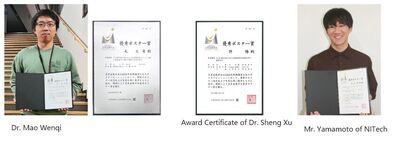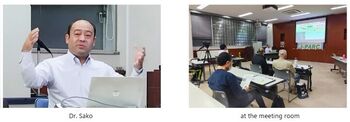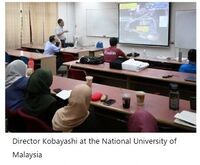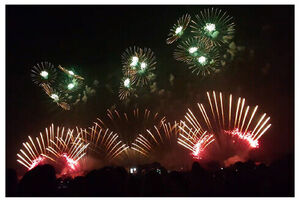J-PARC News December 2023 (Issue #223)
■Prof. Ichikawa of Tohoku University Received Nishina Memorial Prize on November 7
Prof. Atsuko Ichikawa, former T2K experiment spokesperson, now a professor at Tohoku University Graduate School of Science, was awarded the Nishina Memorial Prize 2023 for her achievement entitled "Constraining CP violating phase δ in neutrino oscillations".
The T2K experiment is an international collaboration involving more than 500 researchers from 12 countries. Prof. Ichikawa was involved in the initial design and development of the J-PARC neutrino experimental facility and played a central role in the development of a device called the electromagnetic horn.
■Best Poster Awards at 2023 Fall Meeting of JIMM on September 21
The Japan Institute of Metals and Materials holds annual meetings twice a year, in the spring and the fall, as an opportunity to present and discuss the latest research results. The 2023 Fall meeting was held at Toyama University. J-PARC staff and collaborators from Tohoku University and Nagoya Institute of Technology received best poster awards from over 270 entries in the poster session.
The three award-winning research studies were conducted using the engineering materials diffractometer, TAKUMI, at the Materials and Life Science Facility of J-PARC and in collaboration with the instrument scientists of TAKUMI. The recipients and their award-winning research are as follows.
“Excellent combination of strength and ductility of an ultrafine-grained stainless steel at cryogenic temperatures studied by in situ neutron diffraction”
Wenqi MAO, Wu GONG, Stefanus HARJO, Takuro KAWASAKI from J-PARC, Si GAO from Kyoto University
“Direct measurement of cryogenic elastocaloric effect in a Cu-Al-Mn alloy”
Sheng Xu, Yuxin Song, Xiao Xu, Toshihiro Omori, Ryosuke Kainuma from Tohoku University, Tatsuya Ito, Takuro Kawasaki, Stefanus Harjo, Wu Gong from J-PARC
“Correlation between microstructure and tensile deformation behavior of Mg/LPSO two-phase alloys”
Kazuki Yamamoto(M2), Mika Sugita (M1), Toko Tokunaga, Koji Hagihara from Nagoya Institute of Technology,Tsuyoshi Mayama, Michiaki Yamasaki from Kumamoto University, Harjo Stefanus, Wu Gong from J-PARC
■Grand Prize at the Ibaraki Tech Plan Grand Prix on November 4
The team "Getapon," composed of JAEA staff members, won the Grand Prize at the 7th Ibaraki Tech Plan Grand Prix. The Ibaraki Tech Plan Grand Prix is held annually to discover unique technological capabilities in Ibaraki Prefecture and to promote support for their commercialization.
The team developed a new vacuum pump technology that uses titanium to adsorb and absorb gas molecules, making it possible to generate ultra-high vacuum without using large vacuum pumps. This energy-efficient and space-saving ultra-high vacuum pump is expected to contribute to various fields, including semiconductor manufacturing and materials development.
■Electropositive Metal Doping into Lanthanum Hydride for H− Conducting Solid Electrolyte Use at Room Temperature
A research team from RIKEN, KEK, Japan Fine Ceramics Center, and J-PARC has developed a new electrolyte material that conducts hydride ions (H-), a type of hydrogen.
Electrolytes for batteries require both high ionic conductivity and electric insulation. Currently used liquid electrolytes have the risk of leakage and ignition, but solid electrolytes can reduce such risks, and are expected to enable rapid charging, high energy density, and stable operation over a wide temperature range. Although ionic conductivity of solids is very low at room temperature in general, various solid electrolytes have been developed.
LaH3-δ is a solid material with high ionic conductivity at room temperature, but its electric conductivity was too high for the use of solid electrolyte. The research team synthesized Sr-substituted LaH3-δ with slight O2-incorporation and achieved both high ionic conductivity and excellent electrical insulation at room temperature. The newly synthesized material was shown to perform as a solid-state electrolyte in an all-solid-state cell.
The newly developed solid electrolyte material is expected to open the door to novel H--based electrochemical device operating near room temperature, such as rechargeable batteries based on a new operating principle, and hydrogen storage systems.
For more information, please visit the J-PARC website. https://j-parc.jp/c/press-release/2023/10/20001222.html (only in Japanese)
■J-PARC Photo Contest 2023
The 10th J-PARC Photo Contest was held and received 43 entries this year. After careful selection by a panel of judges, including an invited expert, a photo by Mr. HARADA, Takeshi from the Nuclear Hadron Physics Laboratory of Kyoto University Graduate School was awarded the grand prize.
This work, which photographed the active fiber target used for precision spectroscopy of Ξ hypernuclei, received a comment from the guest judge: "This photo has the power for people to stir their imagination about outside the frame."
The winning entries in the contest are supposed to be widely used as promotional materials, such as a calendar for J-PARC.
■J-PARC Hello Science: Creating Ultra-Dense Matter with Heavy Ion Beams? (October 27)
Dr. Hiroyuki Sako from the Advanced Science Research Center gave a lecture on the J-PARC Heavy-Ion Project, J-PARC-HI, a plan to accelerate heavy ions. This project aims to create and investigate ultra-dense matter through heavy ion collision experiments.
The highest ultra-dense matter in the universe is thought to be located at the center of neutron stars, with a density of about 1015 g/cm3, which is 5 to 10 times as high as that of an atomic nucleus. With J-PARC-HI, it is possible to artificially create ultra-dense matter on Earth by compressing atomic nuclei. In this process, a world-leading heavy ion beam is irradiated onto a target such as gold, causing heavy nuclei to collide. The energy of the heavy ion beam at J-PARC is about 12 GeV per nucleon, which is the optimum energy for compressing atomic nuclei, and it can compress atomic nuclei to a maximum of 6 to 8 times as high as their original density.
One of the main goals of J-PARC-HI is to search for the phase transition between hadrons and quark matter. At present, the mechanisms of phase transitions at high densities are still poorly understood due to the difficulty of performing theoretical calculations from first principles. J-PARC-HI's heavy ion collision experiments aim to discover the phase transition line, the critical point, and the color superconducting phase that have been theoretically predicted for over 20 years, as well as to verify the hadron mass generation mechanism proposed by the Nambu theory. In addition, it is hoped to achieve a variety of other results, such as exploring the mysteries of neutron stars from heavy ion collision experiments and discovering new particles and nuclei with multiple strange quarks using the large number of strange quarks that are generated.
J-PARC-HI is a challenging project, but it has the potential to revolutionize our understanding of matter at extreme densities. The results of these experiments could have a profound impact on our understanding of the universe, including the formation of neutron stars and the origin of the elements.
■Youngsters' Science Festival in Hitachi (October 29)
The " Youngsters' Science Festival " is a precious opportunity to provide children, the eggs of future scientists, with exciting science experiences, to foster children's curiosity for science and develop human resources responsible for the next generation of science and technology. With over 3,000 people attending the festival, the venue thrived with many workshops featuring fascinating science experiments.
The J-PARC booth featured a crafts workshop to build a unipolar motor, whose copper wire coil was spun by the force of a magnetic field. The children immersed themselves in the experiment, forming copper wires into unique shapes. Many children and their parents listened intently to the introduction of J-PARC, showing their great curiosity about our research. We attracted many visitors with Halloween decorations, costumes, and special handmade badges.
■J-PARC Center Director Kobayashi Gives Guest Lectures in Malaysia (October 22 to 25)
J-PARC Director Kobayashi Takashi visited Malaysia and gave lectures at the University of Technology Malaya, the National University of Malaysia, and the Malaysia Nuclear Agency as a promotion tour of the Graduate University for Advanced Studies, SOKENDAI. He gave an overview of J-PARC, ongoing experiments and future projects, and discussed the possibility of future research collaboration. He also introduced opportunities for Malaysian students and researchers to participate in research at J-PARC, such as the SOKENDAI KEK Tsukuba/J-PARC Summer Student Program.
We hope that this lecture will lead to further deepening of relations with Malaysian students and researchers in the future.
■8th Fusion of Humanities and Sciences Symposium (November 2-3, National Museum of Nature and Science)
The world's highest-intensity negative muon beam generated at J-PARC's MLF is also used to study cultural artifacts and other humanities materials. To explore the potential of humanities research using such quantum beams, the KEK Institute of Materials Structure Science has held an annual "Fusion of Humanities and Sciences Symposium" since 2019.
This time, the symposium was held at the National Museum of Nature and Science, Ueno Main Building, with the theme "Exploring History with Quantum Beams - The Horizon of Fusion of Humanities and Sciences Weaved by Accelerators." About 70 people attended, and there were 12 oral presentations on various topics, including coins, metals, asteroids and meteorites, ancient tombs, and tsunamis. A public lecture with three presentations was held on the second day's afternoon. The public lecture attracted a lot of interest, with questions coming from both the audience and about 110 Zoom attendees.
■J-PARC Facilities Tour for Media Reporters (November 14)
A tour of the J-PARC facilities for reporters was held on November 14. Four people from three companies participated.
■Sanpomichi ㊵ -Fireworks and J-PARC
The photo shows a scene from the Tsuchiura All Japan Fireworks Competition held on November 4. Approximately 20,000 fireworks were launched in front of an audience of 600,000 people. Cheers and applause erupted as each firework rose into the night sky. Many visitors may have found a kind of beauty in the transience of fireworks. However, the beauty of fireworks is stored in our brains as memories even after the fireworks have disappeared.
The Materials and Life Science Experimental Facility at J-PARC produces world-leading beams of neutrons and muons. These beams disappear immediately after hitting a sample, but the data obtained is recorded in detail. A "starmine" is a work of art with hundreds of fireworks. J-PARC can analyze the performance of automotive fuel cells, the properties of new alloy materials, and the composition of cultural artifacts as far away as asteroids like Ryugu by repeatedly colliding samples with the world's leading beams of neutrons or muons and accumulating the resulting data.
The fireworks festival in Tsuchiura is a competitive event and a venue for improving fireworks technology. The fireworks artists have already begun to hone their skills for the next festival. J-PARC also continues to work hard to develop more powerful and user-friendly beams and to use them effectively to achieve further research results.










